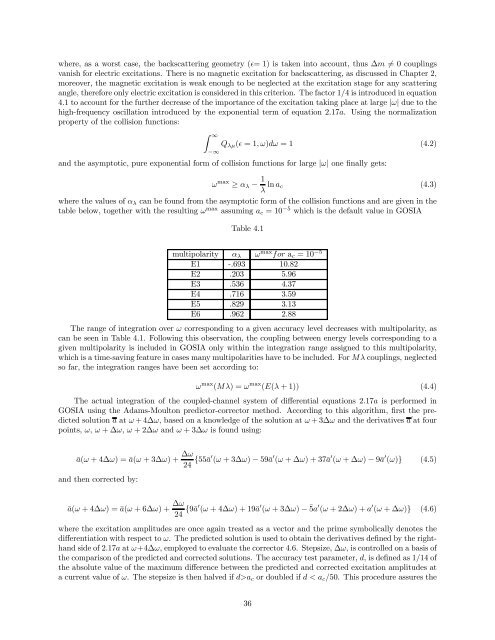coulomb excitation data analysis codes; gosia 2007 - Physics and ...
coulomb excitation data analysis codes; gosia 2007 - Physics and ...
coulomb excitation data analysis codes; gosia 2007 - Physics and ...
You also want an ePaper? Increase the reach of your titles
YUMPU automatically turns print PDFs into web optimized ePapers that Google loves.
where, as a worst case, the backscattering geometry (= 1) is taken into account, thus ∆m 6= 0couplingsvanish for electric <strong>excitation</strong>s. There is no magnetic <strong>excitation</strong> for backscattering, as discussed in Chapter 2,moreover, the magnetic <strong>excitation</strong> is weak enough to be neglected at the <strong>excitation</strong> stage for any scatteringangle, therefore only electric <strong>excitation</strong> is considered in this criterion. The factor 1/4 is introduced in equation4.1 to account for the further decrease of the importance of the <strong>excitation</strong> taking place at large |ω| due to thehigh-frequency oscillation introduced by the exponential term of equation 2.17a. Using the normalizationproperty of the collision functions:Z ∞−∞Q λμ ( =1,ω)dω =1 (4.2)<strong>and</strong> the asymptotic, pure exponential form of collision functions for large |ω| one finally gets:ω max ≥ α λ − 1 λ ln a c (4.3)where the values of α λ can be found from the asymptotic form of the collision functions <strong>and</strong> are given in thetable below, together with the resulting ω max assuming a c =10 −5 which is the default value in GOSIATable 4.1multipolarity α λ ω max for a c =10 −5E1 -.693 10.82E2 .203 5.96E3 .536 4.37E4 .716 3.59E5 .829 3.13E6 .962 2.88The range of integration over ω corresponding to a given accuracy level decreases with multipolarity, ascan be seen in Table 4.1. Following this observation, the coupling between energy levels corresponding to agiven multipolarity is included in GOSIA only within the integration range assigned to this multipolarity,which is a time-saving feature in cases many multipolarities have to be included. For Mλ couplings, neglectedso far, the integration ranges have been set according to:ω max (Mλ)=ω max (E(λ +1)) (4.4)The actual integration of the coupled-channel system of differential equations 2.17a is performed inGOSIA using the Adams-Moulton predictor-corrector method. According to this algorithm, first the predictedsolution a at ω +4∆ω, based on a knowledge of the solution at ω +3∆ω <strong>and</strong> the derivatives a 0 at fourpoints, ω, ω + ∆ω, ω +2∆ω <strong>and</strong> ω +3∆ω is found using:ā(ω +4∆ω) =ā(ω +3∆ω)+ ∆ω24 {55ā0 (ω +3∆ω) − 59ā 0 (ω + ∆ω)+37ā 0 (ω + ∆ω) − 9ā 0 (ω)} (4.5)<strong>and</strong>thencorrectedby:ā(ω +4∆ω) =ā(ω +6∆ω)+ ∆ω24 {9ā0 (ω +4∆ω)+19ā 0 (ω +3∆ω) − ¯5a 0 (ω +2∆ω)+a 0 (ω + ∆ω)} (4.6)where the <strong>excitation</strong> amplitudes are once again treated as a vector <strong>and</strong> the prime symbolically denotes thedifferentiation with respect to ω. The predicted solution is used to obtain the derivatives defined by the righth<strong>and</strong>side of 2.17a at ω+4∆ω, employed to evaluate the corrector 4.6. Stepsize, ∆ω,iscontrolledonabasisofthe comparison of the predicted <strong>and</strong> corrected solutions. The accuracy test parameter, d, isdefined as 1/14 ofthe absolute value of the maximum difference between the predicted <strong>and</strong> corrected <strong>excitation</strong> amplitudes atacurrentvalueofω. The stepsize is then halved if d>a c or doubled if d
















